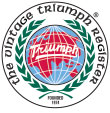Refinishing Triumph Wood Fascia Panels (Dashboards)
by
Art Kelly, ArthurK101@aol.com
The original Triumph wood fascia panels (dashboards) were made of plywood with a finished hardwood veneer. The fascia was a laminate of plywood pieces glued/pressed together at 90 degree angles to each other. This type of constructon protects against warping from moisture or heat. (Solid wood panels will warp – even high priced cars use laminates). A thin hardwood veneer (usually French Walnut) was then added for appearance. The final step in building the fascia panel was the application of a finish (glossy or satin) to the veneer. The purpose of the finish was to seal and protect the panel. That said – described herein is one way to refinish these fascia panels.
I refinished my original TR4 fascia panel in 1992. It was 28 yrs old and the finish was cracked and split. Dirt had gotten into the finish and onto the veneer. The veneer was NOT damaged; it was just dirty. I could not be certain of that until I stripped off the finish.
- a) I used a mild varnish stripper from Sears and a putty knife. The secret was to let the stripper work for five or ten minutes to soften the old finish, then GENTLY use the putty knife to lift the softened finish off. (If the finish is not soft at a spot – then do the same process again. In other words – no “gorilla” work – let the chemical stripper do the work). After that, the veneer was wiped down with whatever the stripper container recommended to clean off any stripper residue. I then wiped the veneer down with mineral spirits to clean off any grease or dirt. At this point, I had a clean, unmarked, unprotected, NON-shiny veneered surface. I did NOT use sandpaper on the veneer itself.
- b) Next I painted the cutout surfaces for the air vents and for the fascia light indicators (directional and ignition). I used a dark brown interior paint that matched the original color. And I also did under the glove box door. (When the fascia is out of the car you can see where that section was painted). The painted sections will be protected from the elements by the final finish.
- c) After the paint had dried, I applied teak oil to the plywood BACK of the fascia panel. Since there is no veneer there, the plywood soaked up the oil. (The natural oils had dried out somewhat over the years). Do not oil the veneer side as this will interfere with the final finish.
- d) Since the original finish for my TR4 fascia panel was high-gloss (i.e. shiny), I bought a can of DAP (brand name) high-gloss polyurethane finish. (Note: You can get the finish in gloss or satin. Some later TR’s had satin finishes. Make sure the polyurethane that you use is rated for exterior use.) I tried applying the DAP several ways. First, I tried spraying with a professional woodworking shop’s sprayer. This was not satisfactory as it resulted in bubbles and fisheyes on the surface. So I had to strip the fascia and clean it again (see above for that step). Second, I tried using an expensive paint brush. This too was not satisfactory because it left streaks. So again I had to strip and clean the fascia panel. Third, and finally, I used a foam sponge brush ($2 for a bag of them at the local Home Depot). I applied one coat, threw away the sponge brush, and let the finish dry for 24 hours (undisturbed and covered by a little paper “tent” so dust could not fall on it). Then I sanded the finish with 1600 grit sand paper (wet), and 2000 grit, also wet. Next I dried it by daubing with paper towels, sat down, had a beer and then, using a new foam brush, applied another coat. I waited 24 hours and repeated sanding, drying, and reapplying the finish. Total 5 coats.
- e) Result – fantastic finish, looks as good as when new and is probably tougher. After 5 1\2 years of use (three years as a daily driver in the Florida sunshine) there are no problems.
Thus, my recommendation is that this fascia panel refinishing, assuming that your veneer is intact, is easy to do, not space science — just takes some time and patience. I would suggest that you simply try it; if the veneer is not damaged to start with, you’ll like it when you are finished.
Art Kelly, ArthurK101@aol.com .
’64 TR4 CT33118L (original owner)
VTR TR4 vehicle consultant
